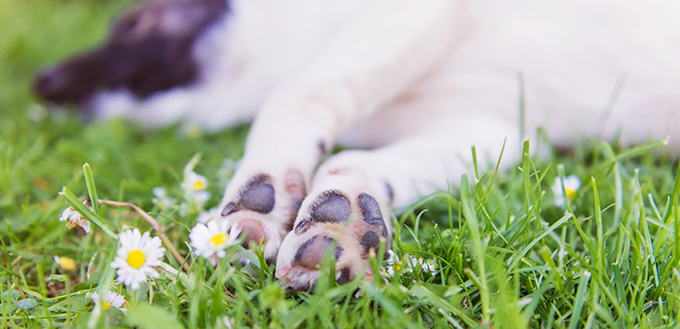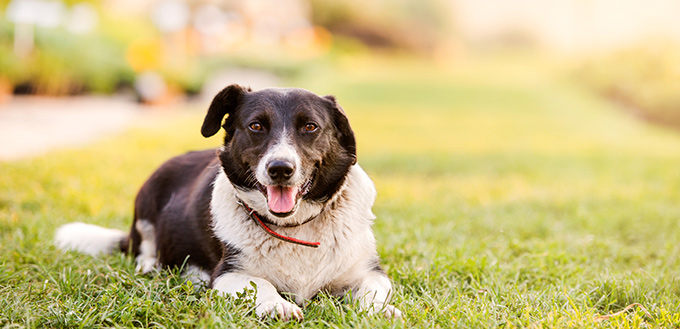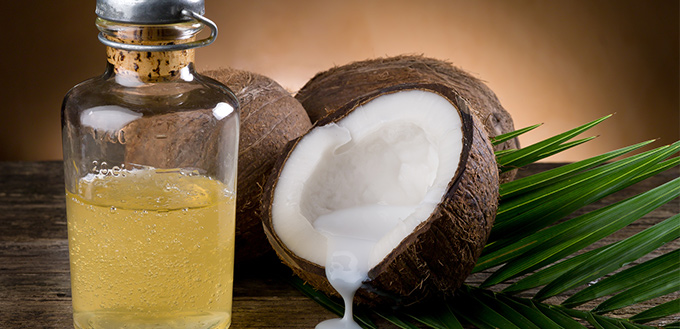Like their human parents, dogs also have a moderate immunity system which means, they can keep many microorganisms at bay. But, when their immune system is not at its best or if it encounters microorganisms that are very powerful, it results in an infection.
One such common infection is the yeast infection on their paws.
What Is Yeast Infection?
So, what in the world is a yeast infection? Yeast is a microscopic organism that lives in practically every place in the world. It is believed that there are hundreds of yeast organisms, and each of it has a unique role to play in their surrounding ecosystem.
Though some are beneficial as they are used for making baked items and beer, others cause infections in humans and animals. These yeasts that cause infections are called pathogenic yeasts. When any living organism comes into contact with these pathogenic yeast, it results in an infection, as the yeast enters your body and multiples rapidly.

What Is Dog Yeast Infection On Paws?
Yeast infection on the skin mostly occurs in areas that are moist and even hidden from sunlight. Your dog’s paw is the right place for these pathogenic yeast to grow as they tend to be moist all the time and are rarely exposed to sunlight. This is why yeast infection is more common on paws than on other parts of the body.
Though it can be found in other closed areas like arm pits, skin folds and ears, they are most common on paws.
Yeast infection is specifically caused by a fungus species called Malassezia. This species thrives on hot and moist climates. As soon as they come in contact with any surface, like the dog’s paw, they start reproducing uncontrollably and invades the entire area as soon as possible. This is how the infection spreads rapidly all over the paw, and if left untreated to other parts of the body as well.
Generally speaking, the Malassezia fungus by itself is not dangerous. But when it becomes a pathogen, it starts giving out symptoms. Unfortunately, scientists are not able to determine the precise reason for the fungus to become a pathogen, though the below items are often seen as contributory causes for this transformation.
- Allergies to certain fungi
- Prolonged use of antibiotics that suppress the immunity system
- Compromised immunity system
- Hypothyroidism
- Cushing’s disease
- Cancer
- External skin parasites
- Concurrent bacterial skin infections
- Lack of nutritional food
- Unclean environment
- Diet
One or more of these factors cause the yeast to become a pathogen, that in turn, affects the dogs on which they grow.
Symptoms Of Dog Yeast Infection
The symptoms of dog yeast infection are:
- The skin around the infected area smells badly, typically like a rotten apple.
- The paws are greasy and oily.
- Intense itching. You will always see your dog doing something in its paws
- Skin irritation
- Inflammation in the surrounding areas
- Skin redness
- Thickened skin
- Sores
- Flaky and crusty skin
- Warm sensation
- Sticky discharge that reflects the overgrowth of yeast
- Possible hair loss
Though you may not notice all the symptoms all through the day, a combination of a few could indicate yeast infection. The primary symptom you should watch for is a rancid and smelly skin. This will be followed by itchiness and it is something that is hard to miss.
Also, when yeast affection affects in one part of the skin, it is more likely to affect in the other parts too, sooner or later. The nature of yeast infection is that it will manifest itself in patches across the entire body. This means, you should look all over your dog’s body to identify such patches.
Are Some Dogs More Predisposed To Yeast Infection on their Paws?
Some dog species are genetically predisposed to yeast infection, and this means, you have to look out for yeast infection more keenly in these species than others.
Some of the species that are predisposed to yeast infection are:
- Bulldogs because of their excessive skin folds
- West Highland White Terriers
- Cocker Spaniels
- Shih Tzu
- Basset Hounds
- German Shepherds
- Poodles
- Maltese
Though the scientific community is yet to ascertain the exact reason for the predisposition of these dogs, it is believed that their genes could determine the reason to attract yeast. Some of these breeds are naturally allergic to yeasts and this compounds their problem. Other brachycephalic species such as Bulldogs are prone because of the makeup of their body.
Besides these species, dogs that have a compromised immunity system, allergies or hormonal infections are also more prone to yeast infections.

Yeast Infection on Dog Paw’s Treatment
Though yeast infection is not life-threatening, it could be annoying for your dog. Over time, it can even cause pain, especially if the paws get blisters and sores.
This is why it is a good idea to take your dog to the vet at the earliest, to help reduce the discomfort that comes with yeast infection.
- Check for allergies
As a first step, your vet will check for allergies to that specific fungi family. This is an important test because if the dog is indeed allergic, it could affect it both internally and externally. Also, the treatment has to be more intense, as the vet will try to give medications that could possibly increase immunity against the fungi to prevent frequent infections.
They identify this allergy through a process called cytology. In this process, a sample is taken using a swab and this is examined under the microscope to determine the nature of the fungi and the reaction of the dog to it. This sterile swab is sent to the laboratory for further testing.
- Medications
Once the vet identifies that the infection is indeed caused by a fungi, the next step is to give the right medications to treat it. Most likely, these will be anti-fungal medications that come in many forms such as medicated wipes, oral medications and even topical creams. Sometimes, the vet will prescribe a combination of these different treatments, depending on the severity of the infection.
- Diet changes
Vets are highly likely to recommend changes in your dog’s diet. Since nutritional deficiency and a compromised immune system are two of the primary factors of yeast infection, the vet may want to review the diet of your dog and even make changes to it.
Generally speaking, when you give your dog a balanced diet that covers all the essential nutrients, the chances for a compromised immune system is less. So, the dog will be able to stave away most of the infections even before it affects it. So, the vet will examine if the dog gets enough nutrients from its food everyday to build a strong immunity system.
Related Post: Anti Yeast Dog Food
Sometimes, the vet may even specify an anti-fungal or anti-bacterial diet for specific breeds, especially those that are predisposed to yeast infections.
One common pattern you will notice across these diet changes is a big cutback on sugar and even carbohydrates. This is a sensible idea because fungus needs glucose or sugar to thrive, so when you cut this out of the dog’s diet, the fungus will not be able to thrive.
But, don’t worry! Your dog will get its energy by burning fat. In fact, fat is considered to be a better source of energy than carbohydrates, but since the body is more tuned to converting carbohydrates into glucose for energy, that is the norm that is being followed. But, you can get the same amount of energy from fats too. So, don’t worry if your vet asks you to cut back on carbohydrates completely. In turn, the protein content will be increased to balance it out.
As a pet owner, you should read the label of dog foods before buying them, as some brands many contain sugar hidden in its ingredients to give your dog the necessary energy. In particular, there are many naturally-formulated dog food and organically grown food that are sure to benefit your dog’s health in a big way.
Related Post: Grain Free Dog Food
- Caring for your dog’s paws
Imagine how annoying it must be for your dog to bear all the itchiness and the sticky substance oozing out of it.
To help your dog to feel better, the vet will ask you to clean and disinfect the infected paws, often. Ideally, you should clean the dog’s paw with paper towels and soak it in a medicated tub or foot soak filled with warm water.
You May Also Like: Dog Paw Washer
A word of caution here. You have to soak the paw in a medicated tub of water and not just spray the medicated water on the infected paws. This difference is important because yeast thrives mostly under the nails and in all the tiny folds that you can never to with a spray. But, when you soak, the water can enter all these areas and remove the yeast.
Remove the paws from the tub after a few minutes and completely dry this area by patting it with a clean towel. Never rinse them again in clean water because the medicated water is meant to retain its effect for many hours, thereby preventing yeast from reproducing rapidly.
Another advantage is that this medication will prevent the dog from licking or scratching its paws.
Related Post: Medicated Dog Shampoos
- Bath with anti-fungal medications
Since the yeast infection happens in patches, it can affect the entire body of the dog. Sometimes, you may not even know which areas are affected as it is tough to check every fold in your dog’s skin.
This is why it is a good idea to give your dog a bath using anti-fungal medications. There are many anti-fungal shampoos available in the market today and these will remove the yeast infection and maybe even prevent it from spreading to other places.
Besides giving a bath with anti-fungal medication, you can also put on a special anti-fungal cream as a coating on your dog’s skin. Again, this will prevent the spread of fungal infection and more importantly, your dog will not be able to scratch these areas.
While shopping for anti-fungal shampoos or ointments, check with your vet. In general, it is a good idea to avoid creams that contain oats, wheat or any other carbohydrate-based ingredient because they can provide the necessary glucose needed for the yeast to thrive.
Related Post: Best Dog Shampoo
Home Treatments
If you think the above treatments are based on chemicals and could affect your dog’s skin health, you can consider home treatments.

Before going into the possible treatments, it is important to note that not all these treatments are approved by doctors or for that matter, the scientific community. Much of it is based on folk medicine and the experience of many pet owners.
- Coconut Oil
Coconut oil is considered to be one of the best treatments when it comes to yeast infection, or any other skin condition for that matter. It contains high amounts of lauric acid, caprylic acid and myristic acid. These acids give coconut a ton of anti-fungal and anti-bacterial properties.
It is used extensively in many tropical countries as a natural treatment for skin conditions. You can apply it as a topical cream on the infected areas and you can also add it to your dog’s diet.
- Kefir
Kefir is a product that looks like yogurt, but comes with more than 30 different strains of good yeast and bacteria that greatly boost your dog’s immune system.
Related Post: Probiotics for Dogs
Since some dogs may develop allergies towards dairy foods, it is best you slowly incorporate Kefir into your dog’s diet. Check for any adverse reactions and stop immediately if your dog is not responding well to it.
In short, yeast infection in your dog’s paw is a fairly common condition that is caused by the rapid growth of fungus due to a host of factors. Fortunately, there are many medical and home remedies available to treat it, so your dog can be happy and healthy again.
Sources:
- Dr. Leigh Burkett, How to Treat Yeast Infections in Dogs, PetMD
- Dog Licking Paws Obsessively: Causes and Treatment, Best Friends Animal Society
Note: The advice provided in this post is intended for informational purposes and does not constitute medical advice regarding pets. For an accurate diagnosis of your pet's condition, please make an appointment with your vet.






